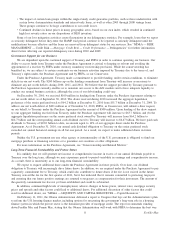Freddie Mac 2010 Annual Report Download - page 21
Download and view the complete annual report
Please find page 21 of the 2010 Freddie Mac annual report below. You can navigate through the pages in the report by either clicking on the pages listed below, or by using the keyword search tool below to find specific information within the annual report.
significant number of loans that defaulted in order to assess the sellers’ compliance with our purchase contracts. For more
information on our seller/servicers’ repurchase obligations, including recent performance under those obligations, see
“MD&A — RISK MANAGEMENT — Credit Risk — Institutional Credit Risk — Mortgage Seller/Servicers.”
The majority of our single-family mortgage purchase volume is evaluated using automated underwriting software tools,
either our tool (Loan Prospector), the seller/servicers’ own tools, or Fannie Mae’s tool. The percentage of our single-family
mortgage purchase flow activity volume evaluated by the loan originator using Loan Prospector prior to being purchased by
us was 39%, 45%, and 42% during 2010, 2009, and 2008, respectively. Since 2008, we have added a number of additional
credit standards for loans evaluated by other underwriting tools to improve the quality of loans we purchase that are
evaluated using these other tools. Consequently, we do not believe the use of a tool other than Loan Prospector significantly
increases our loan performance risk.
As discussed above, our charter requires that single-family mortgages with LTV ratios above 80% at the time of
purchase be covered by specified credit enhancements or participation interests. In addition, we employ other types of credit
enhancements to further manage certain credit risk, including pool insurance, indemnification agreements, collateral pledged
by lenders and subordinated security structures.
Loss Mitigation and Loan Workout Activities
Loan workout activities are a key component of our loss mitigation strategy for managing and resolving troubled assets
and lowering credit losses. Our single-family loss mitigation strategy emphasizes early intervention in seriously delinquent
mortgages and provides alternatives to foreclosure. Other single-family loss mitigation activities include providing our single-
family servicers with default management tools designed to help them manage non-performing loans more effectively and to
assist borrowers in retaining home ownership where possible, or facilitate foreclosure alternatives when continued
homeownership is not an option. Loan workouts are intended to reduce the number of seriously delinquent mortgages that
proceed to foreclosure and, ultimately, mitigate our total credit losses by reducing or eliminating a portion of the costs
related to foreclosed properties and avoiding the additional credit losses that we would likely incur in a REO sale.
Our loan workouts include:
• Repayment plans, which are contractual plans to make up past due amounts. They mitigate our credit losses because
they assist borrowers in returning to compliance with the original terms of their mortgages.
• Loan modifications, which may involve changing the terms of the loan, or adding outstanding indebtedness, such as
delinquent interest, to the UPB of the loan, or a combination of both. We require our servicers to examine the
borrower’s capacity to make payments under the new terms by reviewing the borrower’s qualifications, including
income. Loan modifications either: (a) result in a concession to the borrower, such as a reduction in interest rate; or
(b) do not result in a concession to the borrower, such as those which add the past due amounts to the balance of the
loan, extend the term or a combination of both. Loan modifications that result in a concession to the borrower are
situations in which we do not expect to recover the full original principal or interest due under the original loan terms.
Such modifications are accounted for as TDRs. During 2010, we granted principal forbearance but did not utilize
principal forgiveness for our loan modifications.
• Forbearance agreements, where reduced payments or no payments are required during a defined period. They provide
additional time for the borrower to return to compliance with the original terms of the mortgage or to implement
another loan workout.
• Short sales, in which the borrower, working with the servicer, sells the home and pays off part of the outstanding
loan, accrued interest and other expenses from the sale proceeds, in satisfaction of the full amount of the loan.
For more information regarding credit risk, see “MD&A — RISK MANAGEMENT — Credit Risk,” “NOTE 5:
MORTGAGE LOANS AND LOAN LOSS RESERVES,” and “NOTE 6: INDIVIDUALLY IMPAIRED AND NON-
PERFORMING LOANS.”
Investments Segment
The Investments segment reflects results from our investment, funding and hedging activities. In our Investments
segment, we invest principally in mortgage assets funded by debt issuances and hedged using derivatives. We are not
currently a substantial buyer or seller of mortgage assets, except for purchases of delinquent mortgages out of PC pools.
Our Customers
Our customers for our debt securities predominantly include insurance companies, money managers, central banks,
depository institutions, and pension funds. Within the Investments segment, we buy securities through various market
sources. We also invest in performing single-family mortgage loans, a significant portion of which is from several large
lenders, as discussed in “Single-Family Guarantee Segment — Our Customers.”
18 Freddie Mac
























